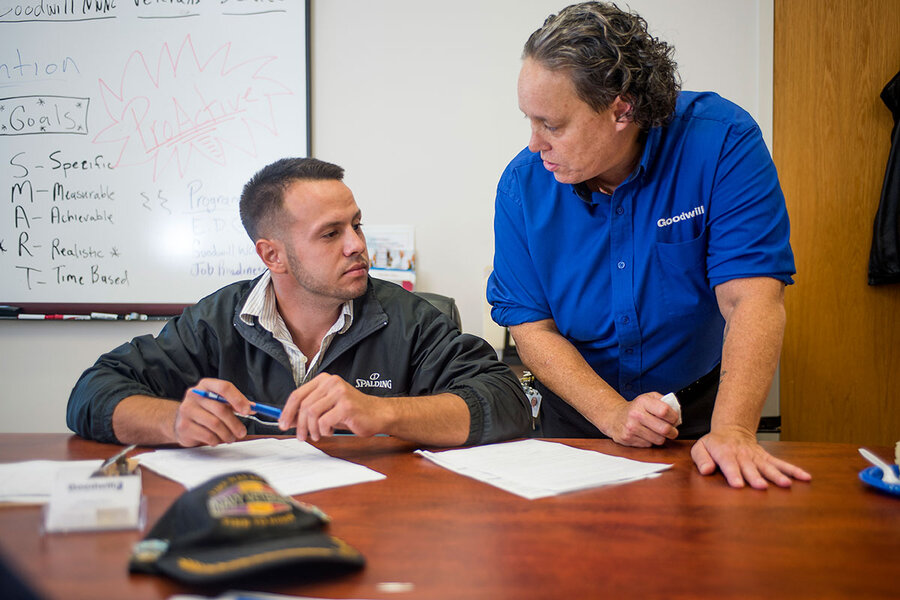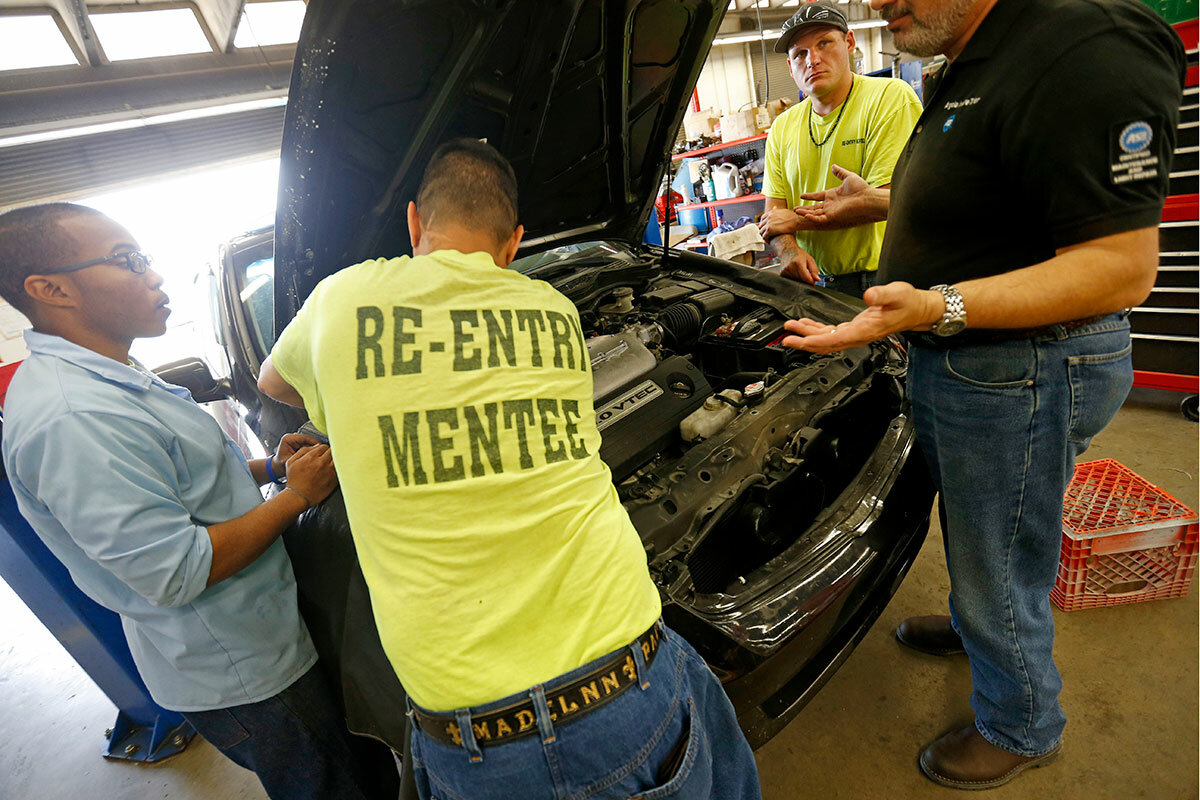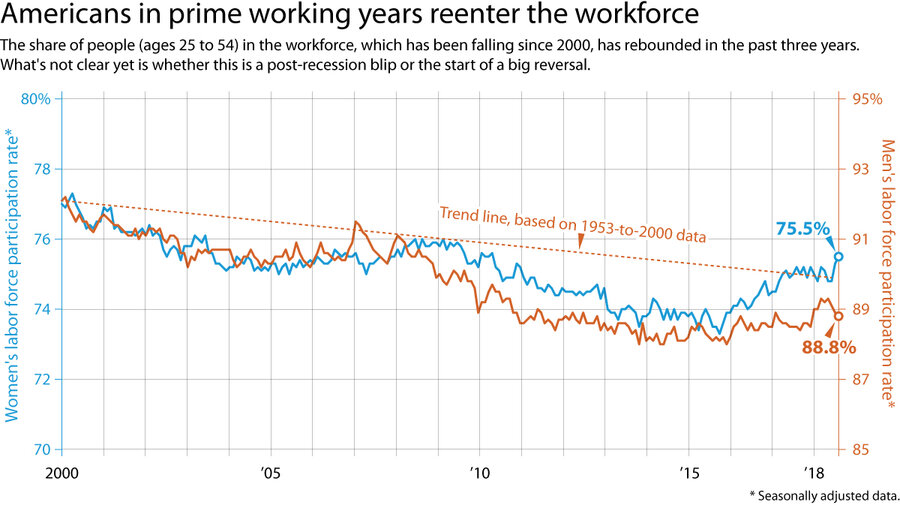Who's left to employ? Tight job market scoops up those on the margin
Loading...
| BOSTON
Almost like clockwork, a growing US economy cranks out new jobs. In July, it added 157,000 positions, the US Labor Department reported Friday; in June, 248,000.
But with unemployment near 20-year lows and some analysts touting “full employment,” are there enough available people to keep filling them?
Population growth can account for about a third to a half of the new hires. But to keep the economy growing, people not currently working need to come off the sidelines to reenter the workforce. And that’s what’s happening. The story of who and how is a sometimes messy process, with people struggling with issues from health to criminal backgrounds getting jobs, losing them, and then gaining the courage to try again.
Why We Wrote This
A tight job market means opportunity – including for Americans with prison records, disabilities, or health challenges. And their participation could strengthen the economy in the long run.
It’s also a tale of progress and hope.
Down the corridor from a law office, 10 floors above Boston’s bustling financial district, a dozen men and women are seated around tables shaped in a U. They’re taking an intensive two-week course here at JVS CareerSolution, learning how to find work despite a background of addiction or criminal activity.
There’s general agreement here that the economy is strong and that it’s a good time to look for a job. But there are complications.
“I have never had a problem finding a job; I have always had a problem keeping a job because of my CORI,” says Alonzo, wearing a bright white T-shirt. (The Monitor did not ask for last names in order to respect the privacy of the class.)
Massachusetts’ CORI, or Criminal Offender Record Information, is an obstacle for many in the class. Mark, a former mechanic, was recently rejected for jobs at two garages because of his criminal background. “You try to change your life,” he says, “and it's not working.”
Then there’s James, who had worked two years at a 24-hour health-food restaurant in nearby Cambridge. “I was willing to stay nights. I am really liking this work,” he says. “I felt that I was headed toward assistant manager.”
A month ago, he got fired. “I think it was my CORI, but I can’t prove it,” he says.
Get-tough policies across America, often resulting in prison terms for minor infractions, are sometimes credited for reducing the nation’s crime rate. But an unintended side effect has been to marginalize many Americans, mostly men and often minorities, which often keeps them from reentering the workforce.
And that’s one reason that, worryingly, the share of people in the labor force has been declining in recent years. But employers are so desperate for workers that they’re lowering requirements for new job applicants and, perhaps, reversing that decline.
“Every single day, we have new employers saying: ‘We are looking,’ ” says Doreen Treacy, vice president of career services at JVS CareerSolution. Where before companies required bachelor degrees, now they accept an associate’s degree. Local hospitals used to ask for two years’ experience before hiring certified nursing assistants. Now, they line up at the JVS CareerSolution’s graduations of CNAs to recruit them, she adds.
The overall labor participation rate has been sliding partly because a growing share of Americans are retirees. What concerns economists is that the rate has been falling even among Americans in their prime working years (ages 25 to 54). For women, it’s been falling since 2000; for men, since 1953.
A falling share of working-age people in the labor force makes it harder for the economy to grow.
The hopeful sign is that in the past three years, the participation rate has rebounded strongly, especially for women. In July, participation among prime working-age women ticked up to a seasonally adjusted 75.5 percent, an eight-year high, according to the Department of Labor. For men, it dipped to 88.8 percent – higher than the all-time low of 88 percent reached in 2015, but the lowest level so far this year. (See chart.)
The question is whether the rebound is simply a return to the trend after the ravages of the Great Recession or the start of a rise that will reverse the long-term slide, says Jay Shambaugh, director of The Hamilton Project at the Brookings Institution in Washington and coauthor of a new Brookings study on the rebound. The next six months should provide a clearer answer, Mr. Shambaugh says.
Anecdotally, employers appear to be willing to overlook a background of criminal activity or substance abuse.
“This is my first time in recovery,” says Toi, one of two women in the JVS CareerSolution group. “I have been in a couple job interviews but they haven’t worked so well. That’s why I came here. Basically, I’m just trying to find my way.”
JVS CareerSolution boasts that 92 percent of those who complete its two-week course either get a job or further training to acquire job skills – Toi’s challenge.
But it’s often a difficult process, with backward as well as forward steps.
“I was an EMT [emergency medical technician] for years; I left there because of my drinking,” says one man who doesn’t give his name. “I think about it all the time. I see an ambulance and I think: ‘I should be doing that instead of flipping eggs.’ ”
Of the people in the group, he says: “It's not bad people, it's just big bad mistakes.”
One huge hurdle for women to enter the workforce is care-giving. More than half of prime-age women outside the formal labor force say they can’t get a job because they’re caring for children or the elderly. “Without child care or elder care, it would not be possible to increase these people’s participation,” the Brookings study says.
Another big obstacle to labor participation is health. Almost 30 percent of prime-age Americans not in the labor force say a disability keeps them from looking for work, according to the study. Even though the recession-linked surge in disability cases is largely over, many would-be workers struggle with health issues.
Ashlee Smith worked as a personal care assistant until last year, when she was diagnosed with multiple sclerosis. She quit her job and has since strung together a series of administrative positions, which don’t require a lot of physical movement, through a temp agency. But her lack of administrative experience has made it hard to land a full-time job.
“I need something more permanent,” she says, typing in her personal data to apply for services at JVS CareerSolution. “The job market is really good, but it’s very much according to your past experience.”








